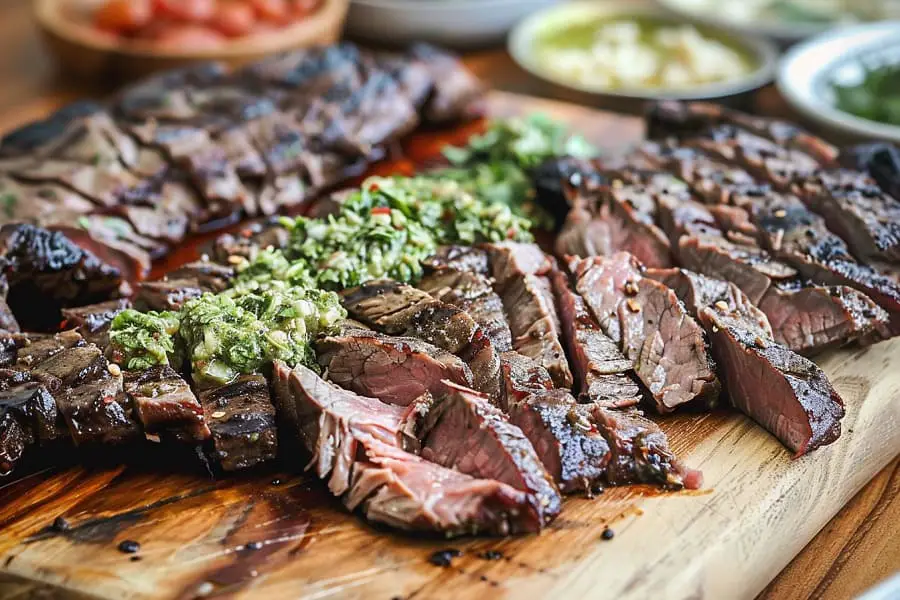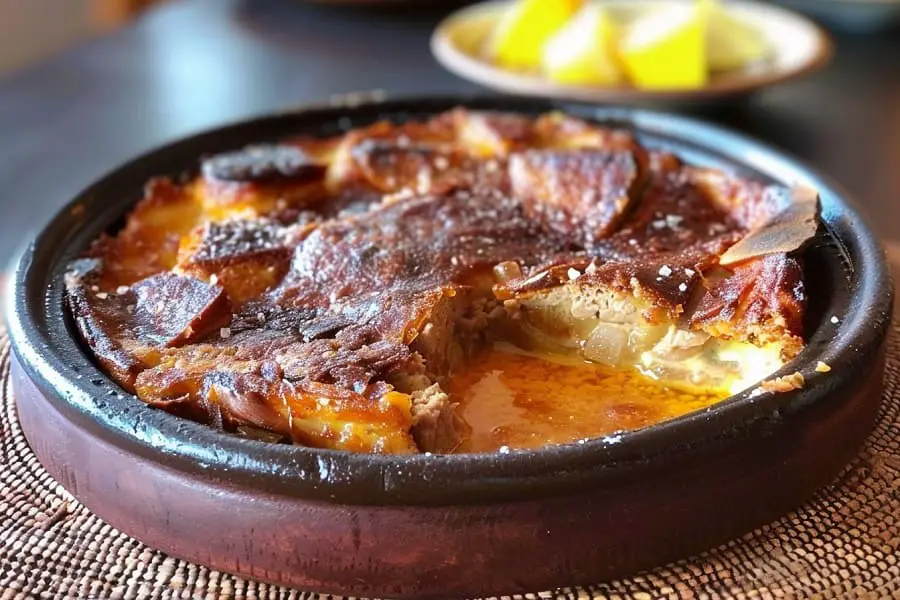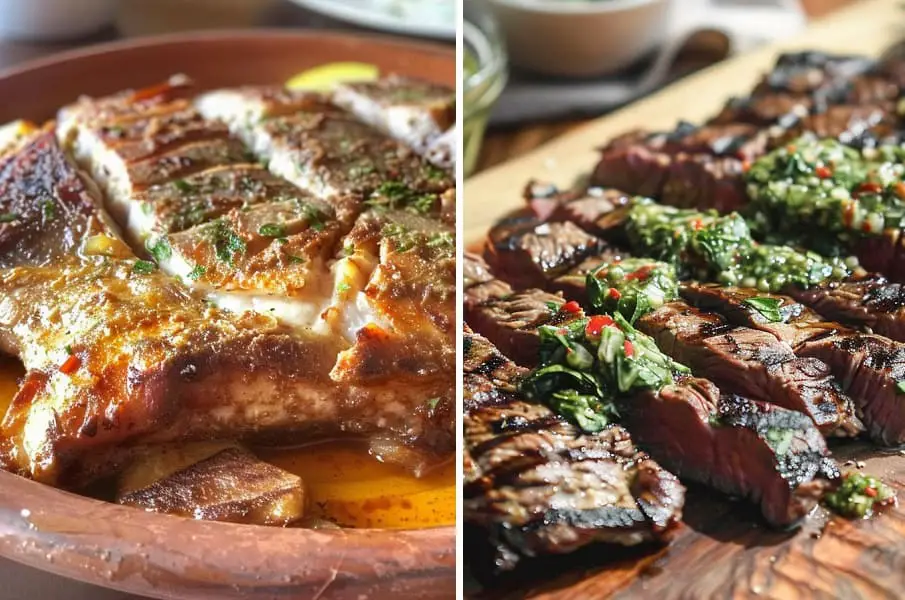When it comes to exploring the rich tapestry of global cuisine, certain dishes capture the essence of cultural heritage and culinary artistry. One such dish is alcatra, a beloved cut of beef integral to both Brazilian and Portuguese traditions. But what is alcatra made of, and why does it hold such a special place in these cuisines?
My journey with alcatra began during a visit to a Brazilian churrascaria, where the aroma of sizzling meats filled the air. The waiter proudly presented a skewer of juicy, perfectly cooked beef, explaining that it was alcatra, one of the prime cuts from the top sirloin. Intrigued by its tender texture and rich flavor, I wanted to delve deeper into its origins and preparation methods.
In Brazil, alcatra is often the star of the show at barbecues, known as churrasco, where it is grilled to perfection. Meanwhile, in the Azores, a group of Portuguese islands, it is traditionally slow-cooked in a clay pot to create a hearty and flavorful stew. This dual culinary identity makes alcatra a fascinating subject for food enthusiasts and home cooks alike.
In this article, we’ll explore the anatomy of alcatra, its cultural significance, and the traditional dishes that showcase this versatile cut of beef. Whether you’re looking to recreate a Brazilian barbecue or a Portuguese pot roast, understanding alcatra’s unique qualities will elevate your culinary repertoire.
What is Alcatra?
Definition and Origin
Alcatra, a term that may sound exotic to many, is a cut of beef that hails from the top sirloin of the cow. Known for its lean yet flavorful profile, alcatra is a favorite in both Brazilian and Portuguese culinary traditions. In Brazilian cuisine, alcatra is often associated with churrasco, a traditional barbecue where this cut is grilled to perfection. The top sirloin, from which alcatra is derived, is located in the hindquarters of the cow, making it a substantial and versatile cut ideal for various cooking methods.
The origin of alcatra’s popularity can be traced back to the culinary practices of the gauchos, or South American cowboys, who would prepare this cut during their communal meals around the campfire. This practice evolved into the modern churrascaria, where different cuts of meat, including alcatra, are skewered and roasted over open flames, a tradition that has become a hallmark of Brazilian cuisine.
Cultural Significance
The cultural significance of alcatra extends beyond its delicious taste. In Brazil, alcatra is considered a centerpiece of social gatherings and festive occasions. The act of grilling alcatra is not just about preparing a meal; it’s a social event where family and friends come together to enjoy each other’s company. The churrasco style of cooking, where alcatra is often featured, emphasizes the communal aspect of dining, reflecting the importance of togetherness in Brazilian culture.
In Portuguese cuisine, particularly in the Azores, alcatra takes on a different yet equally significant role. Known as “alcatra da Terceira,” this dish is a slow-cooked pot roast that showcases the flavors of the region. Traditionally cooked in a clay pot, the beef is marinated with a blend of spices and wine, then layered with vegetables and slow-cooked until tender. This method of preparation not only highlights the flavors of the beef but also the ingenuity of using local ingredients and traditional cooking techniques.
The versatility of alcatra, whether grilled in Brazil or slow-cooked in Portugal, demonstrates its adaptability and importance in these cultures. For those looking to explore new culinary horizons, alcatra offers a gateway to experiencing the rich traditions and flavors of Brazilian and Portuguese cuisines.
The Anatomy of Alcatra
Cut Description
Alcatra is a prime cut of beef sourced from the top sirloin section of the cow, known for its balance of tenderness and rich flavor. This cut is located towards the rear of the animal, just above the hip and below the loin. The top sirloin is a large primal cut that can be divided into several smaller, distinct sections, each with its own unique texture and flavor profile.
The top sirloin section, from which alcatra is carved, is particularly valued for its lean yet juicy meat. It typically has a fine grain and good marbling, which ensures that the beef remains succulent during cooking. When preparing alcatra, butchers often remove excess fat and silver skin, leaving behind a cut that is ready for grilling, roasting, or slow-cooking.
One of the reasons alcatra is so prized in Brazilian and Portuguese cuisines is its versatility. Whether it’s grilled on skewers for a traditional Brazilian churrasco or slow-cooked in a clay pot for a Portuguese stew, this cut can adapt to various cooking methods while maintaining its rich, beefy flavor.
Subdivisions
Alcatra itself can be further divided into smaller, equally delicious cuts. Understanding these subdivisions can help you make the most out of this versatile piece of beef:
- Picanha (Rump Cap): Often considered the star of Brazilian barbecues, picanha is the top portion of the top sirloin. It features a thick cap of fat, which bastes the meat as it cooks, resulting in an exceptionally flavorful and juicy cut. It is usually skewered and grilled, often seasoned simply with coarse salt.
- Maminha (Tri-Tip): This triangular cut, found at the bottom of the top sirloin, is known for its tenderness and slightly lower fat content compared to picanha. It is perfect for roasting or grilling and can also be sliced thin for sandwiches or salads.
- Culotte Steak: Also known as sirloin cap steak, this is a small, triangular cut that comes from the same region as the picanha but without the thick fat cap. It’s tender and flavorful, ideal for grilling or pan-searing.
Practical Tips and Variations
Selecting Your Cut
When choosing alcatra or its subdivisions, look for cuts with a good balance of marbling and firmness. Freshness is key, so opt for meat that is bright red with a slight sheen.
Preparation Methods
- For picanha: Try skewering and grilling it over high heat to create a crispy crust while keeping the inside juicy.
- For maminha: A slow roast or a reverse-sear technique can enhance its tenderness.
Flavor Enhancements
Simple seasonings like sea salt and freshly ground black pepper can highlight the natural flavors of alcatra. For a Portuguese twist, marinate the meat in a mix of garlic, olive oil, and herbs like rosemary and thyme.
Traditional Brazilian Alcatra Dishes
Churrasco

Churrasco, the Brazilian barbecue tradition, is a culinary experience that brings people together over an open flame and a feast of grilled meats. Alcatra, with its tender and juicy texture, is a highlight in any churrasco spread. The word “churrasco” refers to the method of cooking meat on skewers over a charcoal or wood fire, a practice deeply rooted in the culture of the Brazilian gauchos, or cowboys, who would gather around a communal fire to cook their freshly butchered beef.
In a churrascaria, a Brazilian steakhouse, alcatra is typically seasoned with coarse salt and grilled on large skewers. The meat is slowly rotated over the fire, allowing the exterior to develop a flavorful crust while the interior remains succulent. As each skewer of alcatra reaches the perfect doneness, it is carved directly onto diners’ plates, providing an endless flow of deliciously cooked beef.
Recipe Example: Brazilian Churrasco Alcatra
Ingredients:
- 2 pounds of alcatra (top sirloin) cut into thick steaks
- Coarse sea salt
- Olive oil (optional)
- Freshly ground black pepper (optional)
Instructions:
Preparation:
- Begin by preparing the grill. If using a charcoal grill, light the charcoal and allow it to burn until it is covered with a layer of white ash. For a gas grill, preheat to high.
- While the grill heats up, cut the alcatra into thick steaks, about 1 to 1.5 inches thick. This ensures they stay juicy during grilling.
Seasoning:
3. Generously season each steak with coarse sea salt. The salt not only enhances the flavor but also helps to form a delicious crust on the meat. For added flavor, you can lightly brush the steaks with olive oil and sprinkle with freshly ground black pepper, though traditional churrasco often relies solely on salt.
Grilling:
4. Place the steaks directly on the grill over high heat. Grill for about 4-5 minutes on each side, or until a deep brown crust forms. The exact time will depend on the thickness of the steaks and your preferred level of doneness.
- If you have skewers, you can also skewer the steaks and grill them rotisserie-style, turning occasionally until evenly cooked.
Serving:
6. After the steaks are cooked to your preference, take them off the grill and let them rest for a few minutes. This helps the juices redistribute throughout the meat, ensuring each bite is flavorful and tender.
- Cut the steaks against the grain into thin slices. Serve immediately with traditional sides such as farofa (toasted cassava flour), vinaigrette salsa, and pão de queijo (cheese bread).
Traditional Portuguese Alcatra Dishes
Azorean Alcatra

Alcatra, a beloved dish from the Azores, particularly from the island of Terceira, is a Portuguese pot roast that embodies the rustic charm and rich flavors of this Atlantic archipelago. Unlike its Brazilian counterpart, which is often grilled, Azorean alcatra is a slow-cooked stew made with a variety of ingredients that, consequently, infuse the meat with deep, complex flavors. This dish is traditionally cooked in a clay pot, which, therefore, helps retain moisture and enhance the taste.
The origins of Azorean alcatra are deeply rooted in the region’s history and culture. Specifically, this dish was traditionally prepared during special occasions and religious festivals, where families and communities would come together to share a hearty meal. The slow-cooking method used in making alcatra not only tenderizes the beef but also allows the flavors to meld beautifully, resulting in a comforting and aromatic dish that is, thus, perfect for sharing.
Recipe Example: Azorean Alcatra
Ingredients:
- 3 pounds of beef chuck roast, cut into large chunks
- 3 garlic cloves, crushed
- 2 large onions, sliced
- 2 carrots, sliced
- 1/2 cup red wine
- 1/4 cup olive oil
- 2 bay leaves
- 1 tablespoon allspice
- 1 teaspoon black pepper
- 1 teaspoon salt
- 1 teaspoon paprika
- 1/2 teaspoon cinnamon
- 1/2 teaspoon cloves
- 1/4 cup tomato paste
- 4 slices of bacon, chopped
- 2 cups beef broth
Instructions:
Preparation:
- In a large bowl, marinate the beef chunks with red wine, garlic, bay leaves, allspice, black pepper, salt, paprika, cinnamon, and cloves.
- Wrap it up and place it in the refrigerator for at least 4 hours, or better yet, let it sit overnight. This step infuses the meat with rich flavors and tenderizes it.
Cooking:
2. Preheat your oven to 325°F (163°C).
- In a large clay pot or Dutch oven, heat the olive oil over medium heat. Add the chopped bacon and cook until it starts to brown.
- Take out the bacon and set it aside, keeping the rendered fat in the pot.
- Add the sliced onions and carrots to the pot, cooking until they begin to soften. Add the tomato paste and cook for an additional 2 minutes.
Combining Ingredients:
5. Remove the beef from the marinade, reserving the liquid. Add the beef chunks to the pot, browning them on all sides. This process preserves the juices and intensifies the flavors.
- Once the beef is browned, pour in the reserved marinade, beef broth, and the cooked bacon. Stir well to combine.
Slow Cooking:
7. Cover the pot with a lid and place it in the preheated oven. Cook for 3 to 4 hours, or until the beef is tender and easily falls apart. Stir occasionally and check the liquid level, adding more broth if necessary to keep the meat submerged.
Serving:
8. Once the alcatra is done, remove it from the oven and let it rest for a few minutes. Serve hot with traditional sides such as rice, boiled potatoes, or crusty bread. The rich, flavorful broth is perfect for soaking up with bread.
Cooking Tips and Techniques
Marinating
Marinating is a crucial step in preparing alcatra, whether for Brazilian churrasco or Portuguese pot roast. It helps to tenderize the meat and infuse it with deep, rich flavors. Here are some key tips for marinating alcatra:
- Choice of Marinade: For Brazilian alcatra, a simple mix of olive oil, garlic, salt, and herbs like rosemary and thyme works well. For Portuguese alcatra, consider using red wine, garlic, bay leaves, allspice, and cloves to add complexity and depth.
- Marinating Time: Allow the meat to marinate for at least 4 hours, but for best results, let it sit overnight in the refrigerator. This extended marinating time ensures that the flavors penetrate deeply into the meat.
Marinating Tips:
- Use a non-reactive container, such as a glass or stainless steel bowl, to avoid any metallic taste.
- Occasionally rotate the meat to ensure the marinade is evenly distributed.
- If you’re short on time, using a vacuum-sealed bag can speed up the marinating process by allowing the marinade to be absorbed more quickly.
Cooking Methods
The cooking method you choose will greatly influence the final flavor and texture of your alcatra. Here are the primary methods:
Grilling (Churrasco Style):
- Preparation: Preheat your grill to high heat. Skewer the marinated alcatra chunks, leaving space between pieces to ensure even cooking.
- Grilling: Grill the meat over direct heat, turning occasionally to develop a nice crust. This usually takes about 4-5 minutes per side, depending on the thickness of the meat.
- Finishing: Allow the meat to rest for a few minutes before slicing it against the grain to ensure tenderness.
Slow Cooking (Azorean Pot Roast):
- Preparation: Preheat your oven to 325°F (163°C). In a heavy-duty pot, preferably a clay pot or Dutch oven, brown the marinated meat on all sides.
- Cooking: Add vegetables, beef broth, and any remaining marinade to the pot. Cover and cook in the oven for 3-4 hours, or until the meat is tender and falling apart.
- Alternative: You can also use a slow cooker for convenience. Set it on low for 6-8 hours, ensuring the meat remains covered with liquid.
Serving Suggestions
Brazilian Churrasco:
- Accompaniments: Serve with traditional Brazilian sides such as farofa (toasted cassava flour), vinaigrette salsa, and pão de queijo (cheese bread). These sides complement the rich flavors of the grilled meat.
- Sauces: Offer chimichurri sauce for a fresh, tangy contrast to the smoky grilled meat.
Portuguese Alcatra:
- Side Dishes: Pair with rice, boiled potatoes, or crusty bread to soak up the delicious broth. Roasted vegetables or a fresh salad can add a light, refreshing contrast to the hearty stew.
- Serving Tip: For an authentic touch, serve the alcatra in the pot it was cooked in, keeping it warm and allowing guests to help themselves.
Conclusion
In conclusion, alcatra is more than just a cut of beef; it’s a culinary journey that bridges Brazilian and Portuguese traditions. Whether you prefer the smoky, grilled flavors of Brazilian churrasco or the rich, slow-cooked depths of Azorean alcatra, this versatile meat offers something for every palate. By exploring alcatra, you can experience the vibrant cultures and flavors of these regions, thereby bringing a touch of international flair to your dining table.
Moreover, alcatra dishes are perfect for various occasions, from festive gatherings and family dinners to weekend cookouts. The communal nature of these meals reflects the importance of sharing and enjoying food together, thus making them ideal for creating memorable dining experiences.
If you enjoyed learning about alcatra and its culinary significance, consider trying out the recipes and techniques mentioned in this article. Furthermore, don’t hesitate to share your own variations or cooking tips in the comments below. For more delicious recipes and culinary insights, follow our blog and join our community of food enthusiasts.
FAQs
What Type of Meat is Alcatra?
Alcatra is a cut of beef that comes from the top sirloin section of the cow. It is known for its balance of tenderness and flavor, making it ideal for grilling and slow-cooking. In Brazilian cuisine, it is often used in churrasco, a traditional barbecue. Meanwhile, in Portuguese cuisine, particularly in the Azores, it is used in slow-cooked stews.
What is Alcatra, Azores?
Alcatra, in the context of the Azores, refers to a traditional Portuguese pot roast originating from the island of Terceira. This dish involves slow-cooking beef in a clay pot with a blend of spices, red wine, and vegetables. Consequently, the slow-cooking process allows the flavors to meld and the meat to become tender and flavorful, creating a hearty and aromatic meal.
What is the Azores Made Up Of?
The Azores is an autonomous region of Portugal consisting of nine volcanic islands located in the North Atlantic Ocean. Specifically, these islands are São Miguel, Terceira, Faial, Pico, São Jorge, Santa Maria, Graciosa, Flores, and Corvo. Each island has its own unique landscapes, culture, and culinary traditions, thus contributing to the rich diversity of the Azores.
What is the National Food of the Azores?
While the Azores doesn’t have a single “national food,” one of the most iconic dishes is “Cozido das Furnas,” a unique stew cooked using the natural heat of volcanic soil on the island of São Miguel. Additionally, another significant dish is “Alcatra da Terceira,” a slow-cooked beef pot roast from the island of Terceira. These dishes reflect the unique culinary heritage and natural resources of the Azores.


3 thoughts on “What is Alcatra Made Of?”